Google Nexus 9: Preliminary Findings
by Joshua Ho on November 3, 2014 1:00 PM ESTGPU Performance
Following along the same lines, we can also take a look at the GPU performance of Tegra13x in the Nexus 9. This really shouldn’t change too much though as the same GPU is used at the same maximum clock speed of 852 MHz. For those that are unfamiliar with the GPU in the Tegra K1, this is effectively a scaled-down version of their desktop Kepler GPUs.

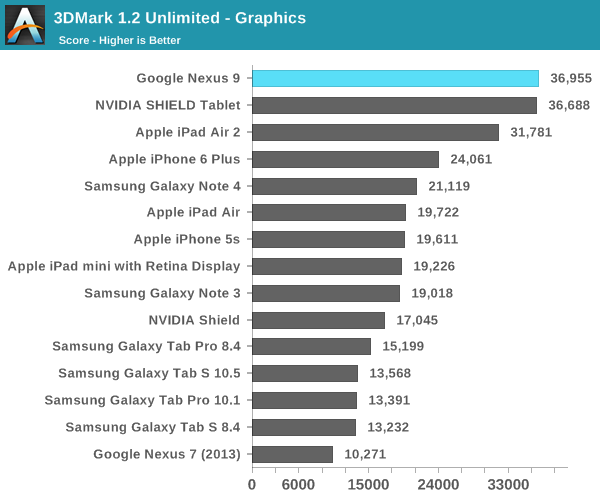
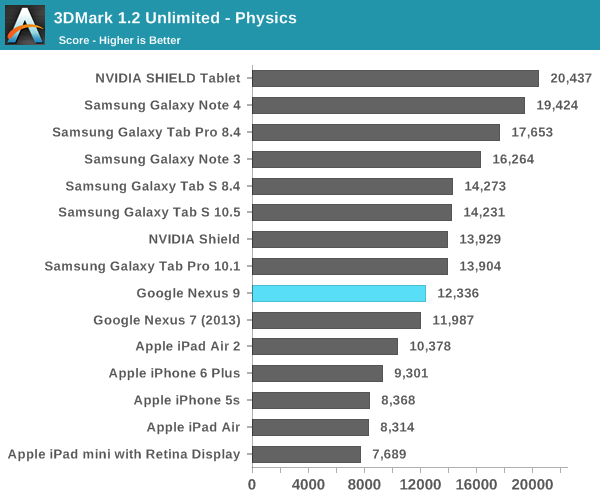
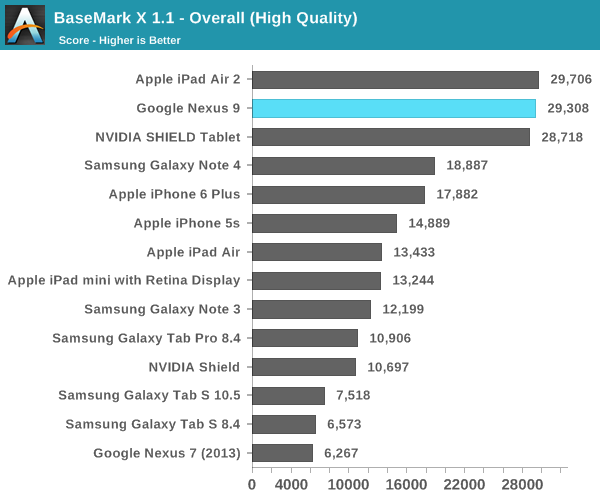
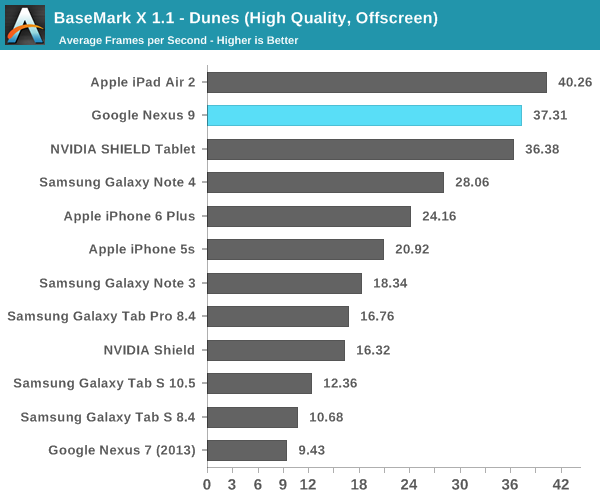
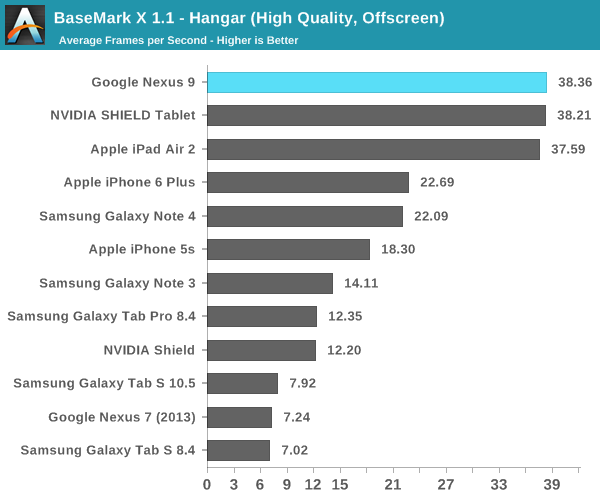
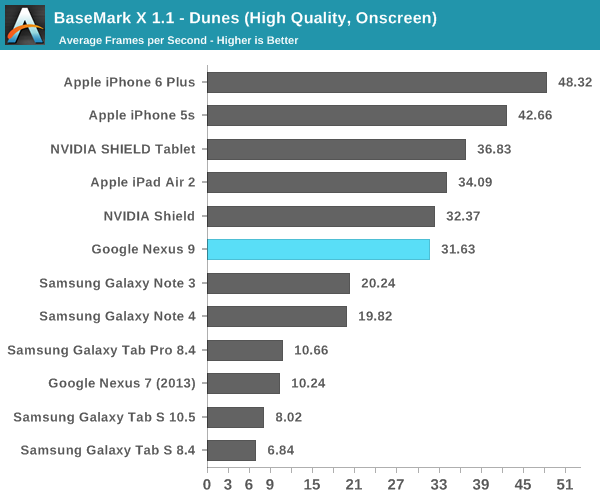

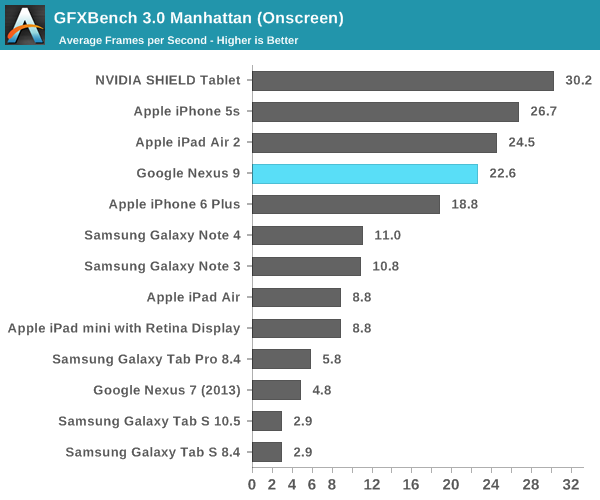
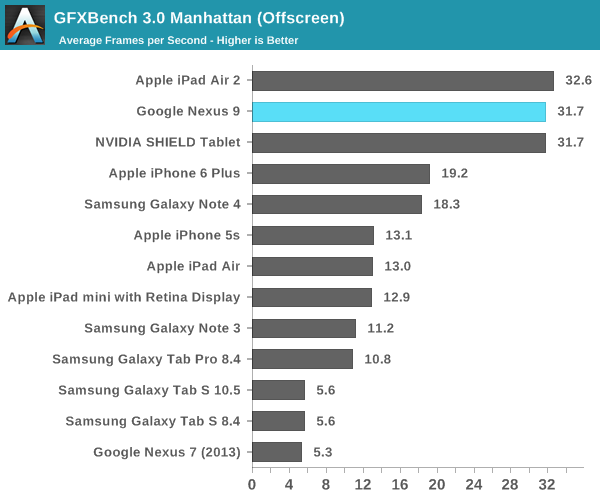
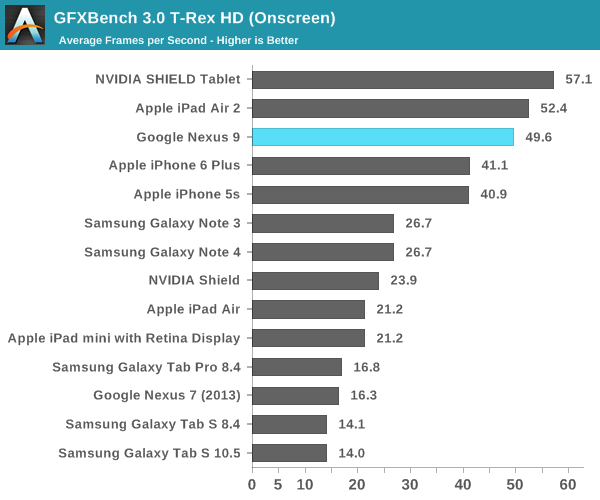
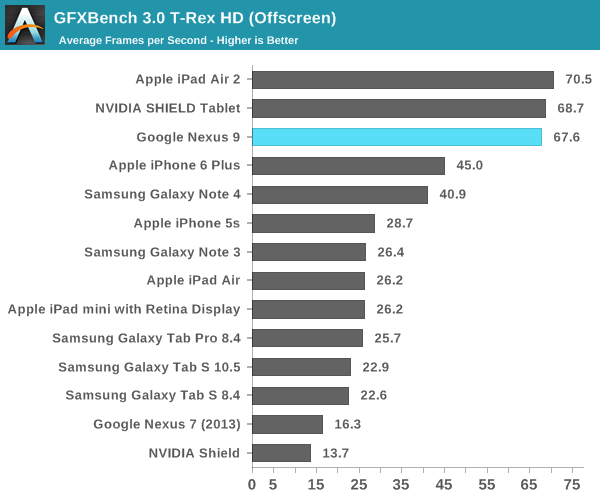
As one can see, the Nexus 9 is effectively equivalent to the SHIELD Tablet in GPU performance. The one anomaly here is 3DMark, which seems to be mostly due to differences in CPU. It's likely that this isn't representative of performance though, as 3DMark's physics test seems to perform better on CPU configurations that rely on larger numbers of cores and higher clock speeds. In the purer GPU tests like Basemark X and GFXBench performance across the board is effectively identical to the Cortex A15 variant of the Tegra K1.
Initial Conclusions
For the most part, the Nexus 9 shows some level of promise as a tablet. While Denver in NVIDIA’s Tegra K1 is a bit bimodal in performance, with sufficient optimization it has immense promise from a sheer performance aspect. While the SoC alone makes the Nexus 9 a fascinating device to look at, the rest of the package has a great deal of potential. The minimalistic design of the device, combined with good material design and stereo front-facing speakers really shows the high-end aspirations of this tablet. While we haven't received anything in the way of accessories, the keyboard folio case seems to be a way of pushing the tablet formfactor in a new direction. This is especially evident when seeing the focus on previous Nexus tablets which seemed to assume touch-only input.
While only a first look, there’s definitely a lot to be impressed by here. However, it will take a full review to really determine whether the Nexus 9 can compete with the iPad Air 2 as a tablet is more than just a function of battery life and SoC performance. In addition, it's hard to draw any real conclusions about this tablet quite yet as the software we received in no way represents a shipping build. Even if inactive, loggers and debug tools generally reduce performance, and it's likely that a great deal of optimization has occurred in the two months since this software build was completed. Once again, we haven't been able to get a newer build, but the full review should be done with shipping firmware.










146 Comments
View All Comments
tuxRoller - Tuesday, November 4, 2014 - link
Pardon, that should've been relatively (as a linear function of screen area it comes to 176 mAh/in2 vs 163 for the ipad).As for the N4, well, I'd simply forgotten about it. However, we still don't have benchmarks for it in 64bit mode. As it is, it seems to be a bit slower than the a15 which shouldn't be the case.
chizow - Tuesday, November 4, 2014 - link
But the N9 has the brighter screen and a smaller battery, and yet N9 has slightly battery life. Not sure how you can be disappointed in this Nvidia effort when they have matched Apple's performance without needing to leverage 20nm and they have in most cases, doubled performance relative to the next closest Android ARM-based competitor and left Intel's Atom based offerings in the rear view as well. Cherry Trail might have proved an interesting part here, but its been delayed, so right now its clear there are really only two choices in the tablet SoC market for pure performance: A8X and Denver K1.testbug00 - Tuesday, November 4, 2014 - link
because the CPU and GPU use all the power in battery life tests, right? The brightness is not equalized, wifi doesn't draw power. Just the SoC.Oh, wait, the screens are standardized to 200nits brightness. And the bightlight is added to power, the wifi is adding to power, the digitizer is adding to power... Wifi tests using are not demanding, so, the SoC is more likely in a low power state, which, makes everything else besides the backlight take a lot more in terms of percentage than normally they would (backlight is still the largest power usage after SoC iirc, with a notable gap between those two and everything else)
Could it be possible that when you equalize the screen brightness (should be able equal power draw) that perhaps a larger screen matters more? Everything else should be about equal.
Low power usage for low power states of the SoCs, wifi radios about the same power, except, the iPad screen is ~29000mm^2, The Nexus 9 is about ~25500mm^2 on its screen.
Do you think that having about a 13% larger area to backlight would reasonably give under 1% less battery life given the battery is only 7% larger?
Apple's chip is likely more effective. The margin by which it is more effective is hard to tell without knowing what percentage of the power draw the tablets each had from the SoC. I would guess at least 15-20%. Which, would mean WORST CASE for Apple, Nvidia's chip's power consumption would be equal at the same node (more or less).
On that note, I think that a K1 A15r3 would likely be faster absolutely as a SoC. Granted, most things don't use 4 threads =]
tuxRoller - Tuesday, November 4, 2014 - link
The brighter screen doesn't matter as the test is done at the same brightness, and the runtimes differed by less than a minute.20nm doesn't make the performance any better unless you actually clock your cpus higher. Apple, iirc, only moved their clocks up 100MHz, to 1.4, while denver is running at 2.3.
I'm dissapointed b/c it looks like denver CAN be fast, but only if running one or two apps for long periods (filling the cache with that vliw optimized code). When multitasking it apparently has serious issues. Hopefully these can be addressed in future revisions to denver.
I'm not comparing denver to atom or other current android offerings as none of them have attempted to go use a radically different arch from everyone else.
DERSS - Wednesday, November 5, 2014 - link
"But the N9 has the brighter screen and a smaller battery, and yet N9 has slightly battery life" -- battery life is measured with equal brightness, so K1's longer battery life is result of smaller screen and dramatical throttling slowdown which is unavoidable since it is 28 nm process (versus 20 nm in A8X).kron123456789 - Wednesday, November 5, 2014 - link
What "dramatical throttling slowdown" are you talking about? Do you know what "throttling" means?DERSS - Thursday, November 6, 2014 - link
Yes, clock drops down to SoC not to overheat and to save battery life.testbug00 - Thursday, November 6, 2014 - link
in a web browsing test? The CPU isn't high enough to throttle... Or, if it is the webpage is more intensive than an 'average' mobile web page, OR, the SoC is terribly designed.While I am very down on Nvidia's mobile efforts due to peak power draws and throttling, it shouldn't be throttling anymore than the A8X in sane web browsing tests...
melgross - Monday, November 3, 2014 - link
We were being told that ARM could never compete with x86, but the A8x is stronger than most i3 low power chips. I assume this new Tegra is somewhere around that as well. The fact that it does compare with a three year old i5 notebook is something that I find incredible.Considering that Apple and possibly others, will continue to upgrade performance in their ARM offerings by substantially greater amounts than Intel is able to with x86, for at least the next few years, means that Intel really does have something to worry about.
kron123456789 - Monday, November 3, 2014 - link
Yeah, but here's what i think — iPad Air 2 and Nexus 9(and all Tegra K1 devices as well) has so much power and that power is used ONLY in benchmarks.